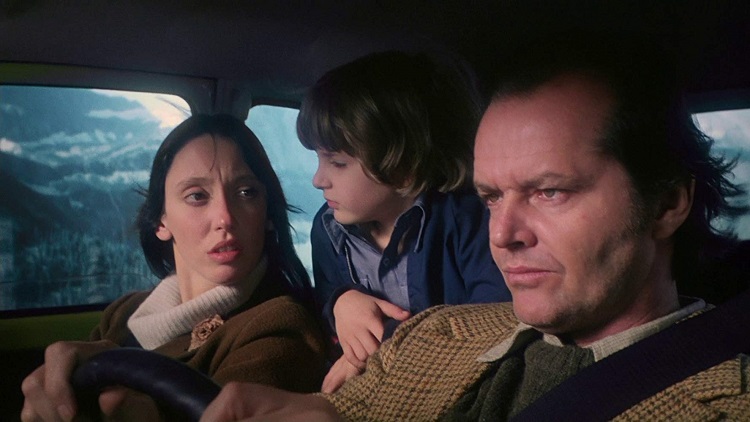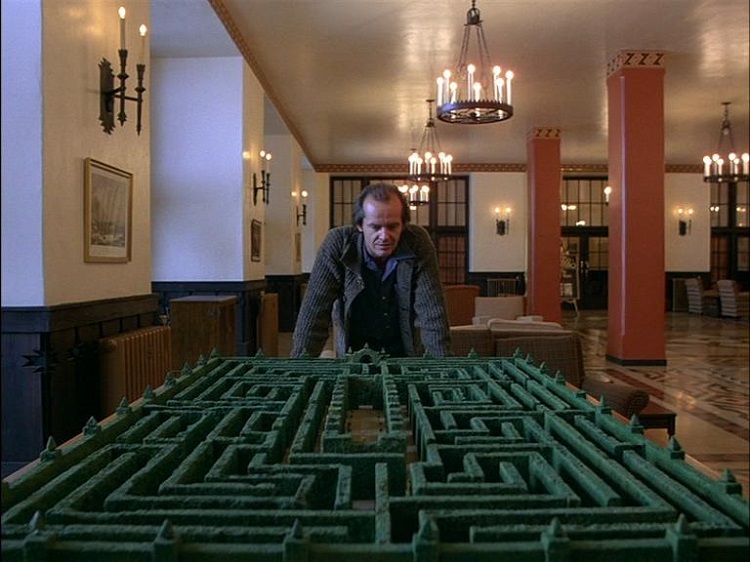40 Years In The Overlook Hotel | Looking Back At The Shining
There’s a joke I made about writing this article: “how do I make a film about people isolated together and one of them going mad topical today?” I thought about that joke while I was watching The Shining’s opening, with its amazing helicopter shots of Jack Nicholson’s character driving through the Rocky Mountains on his way to interview for the job of winter caretaker at the Overlook Hotel. A job that will end with him chasing his wife Wendy and his son Danny around the hotel with an axe, just as his predecessor had done seven years before. And I thought about a conversation I had with a friend back in February. Just like Jack Torrance and his family as they walk around the hotel bustling with life on “The Last Day”, we knew that there was a massive change coming. That soon we would be left alone.
Strictly speaking though, that joke is inaccurate. The Shining is not about a man who goes mad from isolation. Right from the start Nicholson and director Stanley Kubrick make it clear to us that Jack Torrance is a man on the edge of a breakdown. The first time we see him interact with his wife and child, on their drive to the Overlook, his barely restrained aggression is fully on display. This becomes reinforced as his past becomes clearer: alcoholic, abusive, and frustrated by his own failures. Even the job that he has undertaken, the “obligation to his employers” that he trumpets later in the film, isn’t being done by him. The only one we see actually doing the job of caretaker is his wife, maintaining the boilers. For Jack Torrance then the evil in the Overlook Hotel didn’t seep into him and corrupt him. It just gave him an excuse to let out the monster he had inside him all along.

This is a change from Stephen King‘s novel of The Shining, possibly the most significant change. In the novel Jack Torrance is a man trying to reclaim his life after realising his flaws, but who is overwhelmed by the Place of Evil (a Stephen King staple) and destroyed by it. Another significant change is that in the film Jack’s writing is a sham, a pretense to avoid humiliating himself to his wife by admitting he still has writer’s block. In the novel Jack does actually begin writing again, but this act of creation opens him up to the influences of the hotel. Torrance is of course a King self-insert (another staple) and possibly his most brutally honest. King has since been open about his own alcoholism at the time and his feelings of rage towards his family. There’s an element of confessional in the novel which is absent in the movie, a sense that decent people can be drawn to do terrible things without being inherently evil.
That idea of people being terrible things without being terrible people brings to mind another conversation I had with someone about this article. The conversation was about Kubrick’s on-set behavior towards Shelley Duvall, who plays Wendy Torrance in the movie. The connection is that Kubrick was abusive towards her on set, but this was not through inherent abusive tendencies but rather an overwhelming desire to create the film that he wanted. In order to get an appropriately panicked behaviour from her, Kubrick deliberately tormented and harassed her in an instance of involuntary method acting. In fact this makes for the weakest part of the film, where her demeanor of panic undercuts the bravery of her actions and the general competence the character displays throughout. This is another change from the novel, where she is a much more well-drawn character – there’s the scene where Jack screams at her that she ruined his life (when clearly she is the one holding his life together).

Conversations about this movie have been going on since it first came out, of course. Unsurprising since the film is so dense with symbolism. The combination of innovative camera techniques, slow crossfades and rich colour palettes combine to make it feel that literally everything in the film means something. That idea is at the heart of Room 237, a documentary film released in 2012 that interviews a group of fans who each give their own interpretations of the film. These range from the mundane (the film’s use of elements and languages related to the colonisation of America) to the bizarre (the film is a confession by Kubrick to faking the moon landings) to the genuinely thought-provoking (the film’s use of minotaur symbolism, the impossible geometry of the hotel). The juxtaposition of all of those different and sometimes contradictory views serves to highlight the layered nature of the film, and the impact its imagery has had.
Kubrick’s motivation for making The Shining was less artistic and more commercial, though. His previous film Barry Lyndon had underperformed at the box office, and he felt the need for a successful film to maintain his prestige. He decided to create a horror movie, and ordered boxes of horror novels to try to find one to adapt. His secretary got used to the sound of each book hitting the wall as he flung it away after only a few pages. The Shining was the first one that was compelling enough to make him read it the whole way through. And despite Kubrick’s disputes with King and the differences between the two, the spirit of the novel does shine through in the film. It has been argued that the changes Kubrick made were necessary ones, and that the characters and events needed to be stripped back in order to make the story work as a film. In his book On Writing, King himself quotes William Faulkner that a writer must be prepared to “kill their darlings”; and it’s Kubrick killing his darlings for him that King can’t forgive.

All of this is a lot of talking about the film while not really talking about the film, of course, which may give you a sense of the type of film this is. Like most of Kubrick’s best work it feels less like a story that you’re watching and more like a dream that you’re having, a dream that you’re being given. The unreal layout of the hotel, the hideous significance of mundane details, the general absurdities (like the immense size of the hedge maze next to the hotel) all combine to make for an experience rather than a movie. The film was barely recognised at the time (the only award it received was a Saturn for Scatman Crothers as Best Supporting Actor) but in the forty years since its release the film has embedded itself in the public consciousness so thoroughly that there is hardly anyone in the English-speaking world who doesn’t know its plot. Enough so that I think we can all be glad that our isolation is in our own homes and not at the Overlook Hotel.
All images via IMDB

